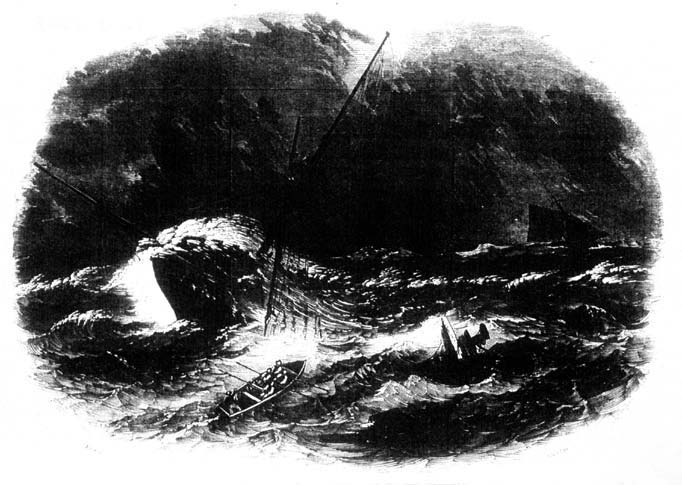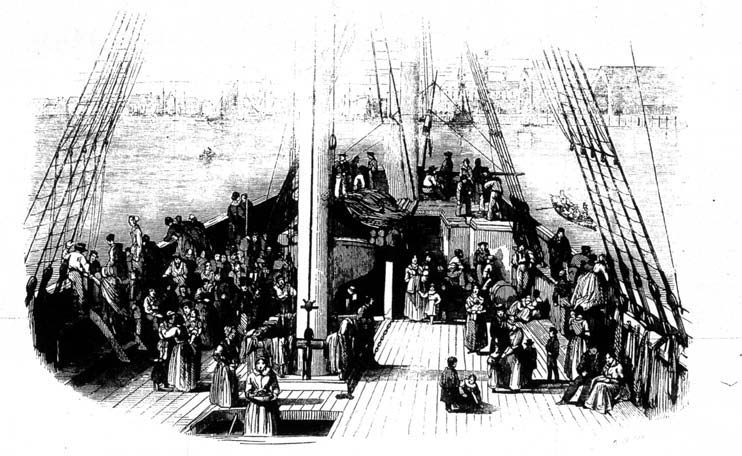III – Coffin Ships
The term ‘coffin ship’ is mainly given to vessels that carried Irish emigrants overseas during the famine of 1845-1850. Many of these ships were freight vessels that had been converted for carrying passengers. In some cases the ships were old sailing vessels which merchants no longer trusted with valuable cargos. Every inch of space was utilised to accommodate hastily built improvised bunks. This meant that in many cases the ships were overloaded beyond the limits of safety. The conditions in the lower compartments were exceptionally terrible.
Those who could not afford the ship fare would gather at the ports and offer what meagre savings they had to sailors in order to gain access to the ships. Others, particularly young people, would sometimes stowaway on departing ships.
Many passengers were already weakened by hunger and were suffering from malnutrition and other famine-related illnesses. Yet some shipowners provided as little food and water as possible; working just inside the legal requirements, if indeed they obeyed the law at all. These ships were often overcrowded and disease-ridden and people endured terrible hardship on the long sea voyages. However, they were the cheapest way of crossing the Atlantic and the only way of escaping the horrors of the famine. Many ships were often short of manpower and during storms weak and hungry male passengers would be forced to lend a hand and do the work of a sailor.[1]

The emigrant ship, Artemisia.
(The Illustrated London News, 12-8-1848)
Food was scarce and at times emigrants had to supply their own rations. The situation for some emigrants was deplorable; having paid the fare, which cost either £3 or £3-10s, they were left with little or no money to purchase food. They then had to rely on the charity of fellow passengers, those better off than themselves. In some cases passengers were thought of as little more than ballast for the ships, and sadly, the remains of those who died during the voyage were consigned to the bottom of the sea. There are horror stories of sharks following ships because of the plentiful supply of bodies they were guaranteed.
Ship operators frequently smuggled additional pas-sengers on board and as these people were not listed in the ship’s manifest, it is impossible to determine exactly how many lives were lost to the sea. Emigrants did the cooking themselves and this was an ordeal in itself, with passengers forced to queue for hours to use the small stoves available on the open deck. Those who had fallen ill depended on others to procure their meagre rations. Drinking water was usually in short supply, adding to the suffering.
In favourable conditions the voyage to America would take about six to eight weeks, but during bad weather, such as storms and gales, the journey could take as long as twelve weeks.[2]
Some landlords used the famine as an opportunity to clear their land of tenants who could no longer work and were becoming a burden, by paying for their passage to Canada and the United States. The following is just a sample of the loss of life during the Atlantic journeys. In July 1846, the Elizabeth and Sarah sailed from County Mayo, bound for Canada. There were 276 passengers on board, but only 212 were listed in the ship’s manifest. To sustain these people with fresh water for the duration of the journey there should have been 12,532 gallons in storage, however, the ship carried only 8,700 gallons. Each passenger was entitled to 7 lbs of provisions per week, but in this case none were issued. The unfortunate people had to depend on the meagre rations they had managed to acquire before leaving Ireland. The journey took eight weeks, during which forty-two people died.

Departure of an emigrant ship.
(The Illustrated London News, 6-7-1850)
In 1847, the Lord Ashburton was inspected at Grosse Île, Canada, and was labelled a ‘disgrace to the home authorities’. It seems that 107 passengers had died during the journey from Ireland.
In August of 1847, the Virginius sailed with 476 passengers. Conditions were so appalling on board that 158 of them died during the voyage. The filth and dirt on board some of these vessels created such an ‘effluvium as to make it hard to breathe’. Corpses were sometimes dragged up on deck using boat hooks as even relatives of the dead were fearful of being contaminated by disease. Sometimes sheets were used to remove the dead and convey them to their last resting place, the sea. Having reached their destination, people continued to die in their droves. The Agnes arrived in Canada with 427 passengers. After being held in quarantine for fifteen days, only 150 people were still alive.[3]
There was also the danger that a ship might sink en route and lose its entire complement of passengers and crew. Between 1847 and 1853, some fifty-nine emigrant ships sank while making the journey to America. Among them was the Exmouth Castle, which resulted in even more deaths than the loss of the St. John. The ship departed from the port of Derry on 25 April 1847 and was bound for Quebec, Canada. The vessel was registered to carry 165 passengers; but with two children being counted as one adult, there may have been as many as 240 on board. As the ship lost sight of land a light breeze began to blow, and by midnight it had turned into a storm. The storm increased in violence and lasted for several days. The brig fought for survival until eventually, on 28 April, having been driven back by the sheer force of the storm, it struck rocks off the coast of Scotland and sank. Only three sailors survived. In June 1848, the Commerce went down with sixty-eight passengers off Port Manton Island, Nova Scotia. On 24 August 1848, the Ocean Monarch sank off Liverpool resulting in 178 of its 306 emigrants being lost. The paddle steamer, Londonderry, ran into trouble while ferrying people from Derry to Liverpool in 1848. It was the first leg of their journey to America. A sudden storm battered the steamer and the captain gave orders that all passengers were to be locked into a cabin below deck for the duration of the storm. The compartment was much too small to accommodate the 174 passengers and they struggled for air throughout the night. While some were crushed, others suffocated. By the time the doors were opened the following morning 31 women, 23 men and 18 children had lost their lives. On 2 January 1849, the Cushlamachree sailed out of Galway, bound for New York. The ship was owned by Patrick Lynch of Galway and was carrying 119 passengers. The Cushlamachree met with terrible weather conditions from the very beginning and the passengers had to endure a the majority of the brutal eight-week voyage in the overcrowded hold, arriving in New York on 1 March 1849. While no passengers were lost, they never forgot the hardship and frightening experience of this crossing.[4]

Between the decks of an emigrant ship.
(The Illustrated London News, 17-8-1850)
While the above stories are horrific, they fall short of relating the day-to-day hardships endured by individuals, which were shocking beyond words. Mothers watched their children die, almost too scared to hold them lest they contract disease. They later watched as their pitiful emaciated remains were dropped into the sea. Such scenes had become commonplace.

The wreck of the Mary Elizabeth.
(The Illustrated London News, 22-9-1849)
While summer sailings presented their own set of sufferings, winter sailings were horrendous, with icy cold winds compounding the misery of the passengers. Some years after the famine, Dr Curtis, from Dublin, who was a former ship’s surgeon, wrote, ‘The torments of hell, might, in some degree, resemble the sufferings of the emigrants on these ships.’
Those who survived the coffin ship voyages carried terrifying stories of the journey ashore upon arriving at their destination. The high mortality rate among passengers was evident and the survivors’ stories shocked and frightened many people. To counteract such stories, shipowners published accounts of successful voyages in newspapers. Henry Comerford, co-owner of the brig St. John, placed the following notice in the Galway Mercury in January 1847:
… the failure of the potato crop in Ireland will considerably increase the demand for labour in America, upon which poor Ireland has principally to rely for receiving a supply of food ... There can be no doubt, whatever, of obtaining immediate employment and high wages.[5]
Most people did not trust these reports; however, true or untrue, the coffin ships were the only way of escaping the famine. Obviously some ships were better than others; this could also be said of the captains and their crews. The more superior ships had more than one emigrant deck and would have been considerably healthier. The following letter of acknowledgement was written in 1847 by Michael Burke and John Geoghegan, and sent to Captain Stitt of the Midas:
At the request of our fellow passengers, in all 190 souls, we beg to return you our sincere and heart-felt thanks for your kind and fatherly attention to all our wants and comforts during the voyage, in giving us all full share of provisions and plenty of water, and medicine late and early when required, and your constant attention on all occasions for which we shall be ever grateful and an account of which we have written to our friends in poor old Ireland.[6]

The wreck of the Floridion.
(The Illustrated London News, 10-3-1849)

Advertisements for emigrant ships Helena and Albion out of Galway in 1848.
(The Galway Mercury, 8-4-1848)

Advertisements for emigrant ship, Cushlamacree.
(The Galway Mercury, 18-6-1847)

The deck of the Artemisia.
(The Illustrated London News, 12-8-1848)
Notes
[1]Boston Irish Reporter: ‘Cohasset Monument Honors Famine Victims’ (October 1996).
Boston Sunday Herald: ‘Cohasset Ceremony Recalls Shipwreck’ (10-10-1999).
[2]Boston Irish Reporter: ‘Cohasset Monument Honors Famine Victims’ (October 1996).
Boston Sunday Herald: ‘Cohasset Ceremony Recalls Shipwreck’ (10-10-1999).
Kennedy, M., ‘The Winter Voyages of the Famine Ships Cushlamachree and Londonderry’.
Illustrated London News (8-5-1847).
[3]Boston Irish Reporter: ‘Cohasset Monument Honors Famine Victims’ (October 1996).
Boston Sunday Herald: ‘Cohasset Ceremony Recalls Shipwreck’ (10-10-1999).
Litton, Helen, The Irish Famine: An Illustrated History (1994), pp. 105, 107.
Ó Cathaoir, Brendan, Famine Diary (1999), pp. 123, 131, 149.
[4] Cunningham, John, ‘A Town Tormented by the Sea’: Galway 1790-1914 (2004), pp. 155, 156.
Internet Articles: http://www.islayinfo.com/Exmouth-islay-tragedy.html, ‘Emigrant Ship Exmouth.’
Kennedy, M., ‘The Winter Voyages of the Famine Ships Cushlamachree and Londonderry.’
Litton, Helen, The Irish Famine: An Illustrated History (1994), pp. 105, 107.
Ó Cathaoir, Brendan, Famine Diary (1999), pp. 123, 131, 149.
[5] Cunningham, John, ‘A Town Tormented by the Sea’: Galway 1790-1914 (2004), pp. 155, 156.
Internet Articles: http://www.islayinfo.com/Exmouth-islay-tragedy.html, ‘Emigrant Ship Exmouth’.
Kennedy, M., ‘The Winter Voyages of the Famine Ships Cushlamachree and Londonderry’.
Litton, Helen, The Irish Famine: An Illustrated History (1994), pp. 105, 107.
Ó Cathaoir, Brendan, Famine Diary (1999), pp. 123, 131, 149.
[6]Boston Irish Reporter: ‘Cohasset Monument Honors Famine Victims’ (October 1996).
Boston Sunday Herald: ‘Cohasset Ceremony Recalls Shipwreck’ (10-10-1999).
Cunningham, John, ‘A Town Tormented by the Sea’: Galway 1790-1914 (2004), pp. 155, 156.
The Galway Mercury: ‘Irish Sufferings – Whig and Tory Sympathy’ (5-6-1847).